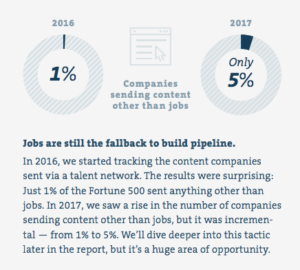This week on the Weekly Dose I review the talent pipelining platform Candidate.ID. Candidate.ID’s Talent Pipeline Platform provides one central, unified SaaS solution that manages and optimizes every tactic used to find, attract, engage and nurture candidates.
So, what does it really do?
Candidate.ID calls itself a talent pipeline platform which makes it this awesome cross between CRM, ATS, email marketing, and screening tech. Candidate.ID’s unique scoring algorithm identifies with laser focus, exactly which candidates within your talent pipeline are ready for a hiring conversation.
How does this work?
Think of it like this, you have candidates at all levels within your pipeline, some are just at the awareness level, some are learning more about you, others are considering applying, and others have already applied. Candidate.ID’s system figures out at which level a candidate is at and then automatically nurtures them based on the level they are.
Personalization is critical to candidate experience and candidate close. The only way you can do this is by measuring the level of interaction, and Candidate.ID’s algorithm has proven effective in getting each level to the finish line.
What I like about Candidate.ID:
– The platform measures ROI of pipeline effectiveness and shows you which candidates to prioritize for your team, so they know who to go after in the moment based on which candidates are ready to make the final step.
– Candidate.ID uses multiple levels of tracking that include cookie tracking, IP recognition, and fingerprint tracking across devices. This allows you to track candidates through content, social media click tracking, text message click tracking, career and corporate websites, etc.
– A dashboard of real-time candidate traffic that shows you the entire journey of a candidate’s interaction with you. You see everything a candidate does in engaging with your employment brand.
– Not only do you see this with new candidates coming in, but one of Candidate.ID’s most powerful functions is being able to nurture your entire ATS database, and show your team which candidates are ready and when the right fit is close.
Candidate.ID is an enterprise-level tool. It works best when you’re hiring roughly 15+ of the same kind of position per year at a minimum. A great example is a client that had 3,000 design engineers in their database. They put them into Candidate.ID and started nurturing them and within 8 weeks they were able to make 18 hires and 25 others in final conversations, 500 that were being warmed up for the future.
Candidate.ID is a sophisticated recruiting tool that can be used by corporate TA, staffing and RPO alike, given you have the volume to make it worth the investment. It’s powerful, and it will put your team at a competitive advantage for talent. Definitely a tool you should demo if you’re in the enterprise space and hiring mid to senior level talent (probably $40k – $150k+). This would not be something for high volume hourly hiring.
The Weekly Dose – is a weekly series here at The Project to educate and inform everyone who stops by on a daily/weekly basis on some great recruiting and sourcing technologies that are on the market. None of the companies who I highlight are paying me for this promotion. There are so many really cool things going on in the tech space and I wanted to educate myself and share what I find. If you want to be on The Weekly Dose – just send me a note – timsackett@comcast.net
Want help with your HR & TA Tech company – send me a message about my HR Tech Advisory Board experience.





